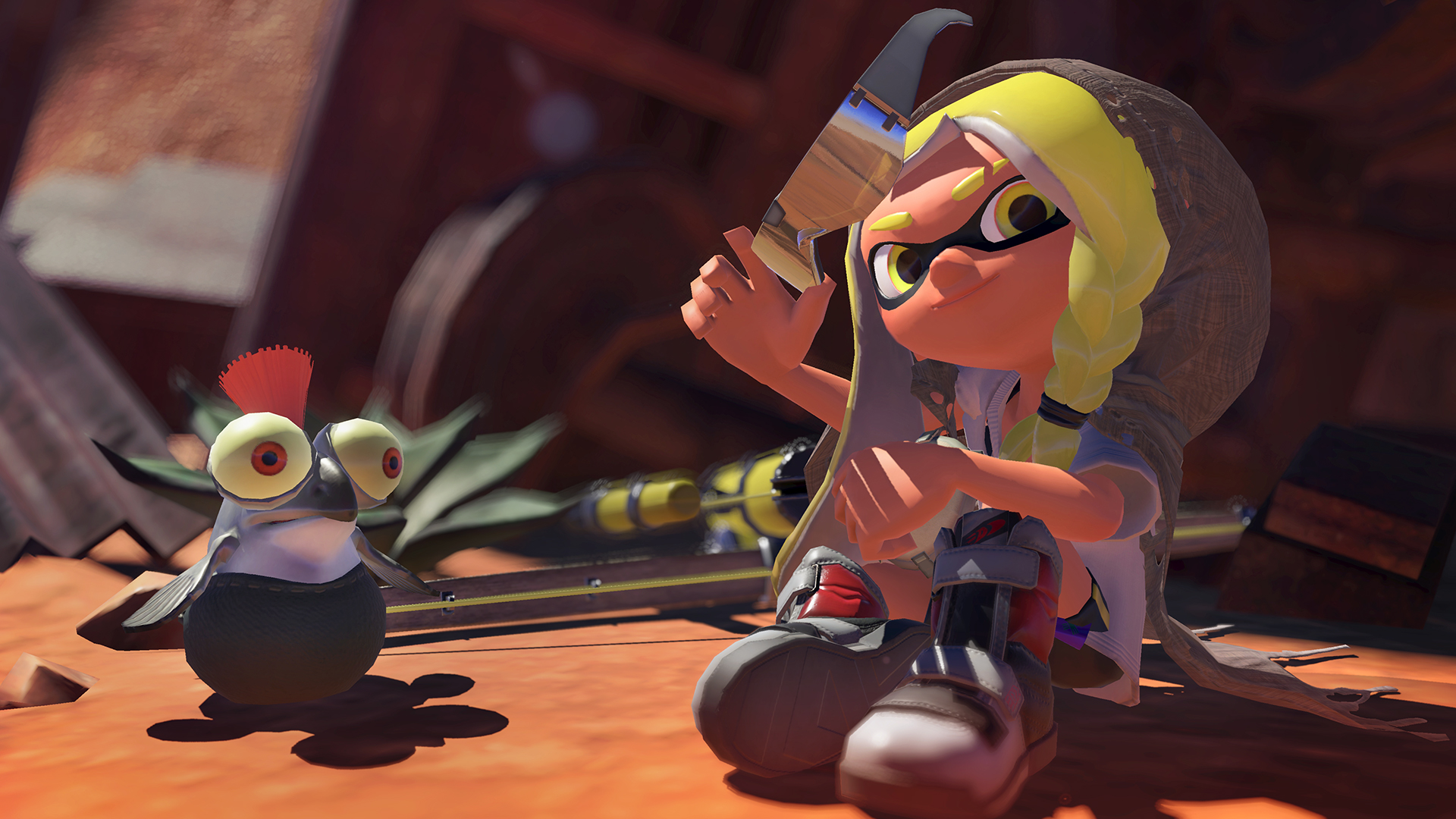On the surface, Splatoon is an unlikely franchise to have a devoted queer fan base.
The game started its life in 2015 on the unpopular Wii U console to slow sales. Since then, Splatoon 2 (2017) and Splatoon 3 (2022) have released on the Nintendo Switch, to greater popular success. Splatoon 3, which dropped last month, has swiftly become the Switch’s fastest-ever selling game in Japan, shifting 3.45 million copies in its first three days—even more than another beloved queer Nintendo staple, Animal Crossing: New Horizons.
Splatoon is a kid-friendly third-person shooter where players spray colourful ink instead of bullets. Teams of four compete in fast-paced battles to see which side can cover more of the stage in their colour—like if paintball cared about painting the ground. Also: you’re a shape-shifting cephalopod known as an inkling or octoling. Players use their humanoid form to shoot, slosh, splash or slash ink onto the stage, then shift into squid (or octopus) form to swim through their team’s ink for fast movement and ink regeneration. Get hit by enough enemy ink, and you’ll be splatted—out the game for a few seconds until you revive at base.
Each of the three games has a robust single-player mode with a handful of cool characters, but the story takes a back seat to platforming and level design. There are also prominent NPCs who conduct the world, singing superstars with funny banter that players never actually get to talk to.
Unlike many other games embraced by queer folks, there are no explicitly queer characters, no homes to lovingly decorate, no love interests to pine after and no endearing conversations with your friends. But that’s kind of the point. From the way online communication encourages creativity and shitposting, to the charmingly chaotic game world, to the fluidity in character customization, Splatoon has a whole host of design decisions that seem designed to appeal to baby queerdos.
Curated communication
Unlike many online team-based games, Splatoon has no integrated voice chat. In-game communication is limited to calling “Booyah” and “This way” (or “Ouch” if you’re out of commission). Removing the threat of homophobic randos makes the playspace much more welcoming than other online games, and players can use external methods to talk to IRL friends.
But Splatoon’s game world feels full of life, as the city you load into is filled with other players displaying doodled messages. These float over players’ heads, or display on walls as graffiti. There’s a healthy mix of memes, fan art and game references—alongside omnipresent declarations of queerness. Missives reading “I’m gay,” “Protect trans kids” or “We all love men” are frequent sights. This has long been the case: back in Splatoon’s heyday there was gay squidposting, and Splatoon 2 had a huge trans and non-binary pride swell after launch.
Nobody is better at the internet than queer teens. They rule Tumblr and make Instagram meme pages. Online spaces have long been a where place queer and trans people go when the real world is less than ideal—so of course we’ve set up in the post-apocalyptic hub city of Splatoon 3.
An anarchic world
Splatoon regularly hosts online Splatfests, weekend-long mass battles where players pick teams based on a question and battle it out for supremacy. Are you Team Ketchup or Team Mayo; vampire stan or werewolf stan; pro-fork or pro-spoon? In Splatoon 2, the climactic Splatfest was order vs. chaos. Chaos won—and Splatoon 3 has embraced the fan-annointed anarchy. Now, Splatsville, the game’s central location known as the “city of chaos,” exists as a jumble of highrises, neon lights, criss-crossing walkways and unlikely public art.
Each Splatoon edition has its own NPC idols hosting and running the Splatfests. Splatoon 3 breaks from the franchise’s usual pair of girls to bring us a three-fish band, Deep Cut: peppy inkling Frye, cool octoling Shiver (who was extensively head-canoned as non-binary) and literal manta ray Big Man. This makes Splatfest three-way events, adding an extra layer of chaos into the multiplayer mix. Deep Cut’s signature song, “Anarchy Rainbow,” mixes Japanese odori, Brazilian samba and Bollywood inspirations. Chaos isn’t edgy and uncaring: it’s a celebration of diverse perspectives.
The inklings and octolings of Splatsville have no government, no structures, no authority. They exist only to vibe and party, free from responsibility and restrictions. Queers love chaos because it’s an absolute rejection of the social norms that have long been used to repress, harass or stigmatize us. Our reclaimed umbrella term of “queer” refers to oddness. “Gay” as in happy has shades of being too joyous, too mirthful. “Trans” and “non-binary” both nod to breaking social norms in their etymology, moving across—or beyond—the whole arbitrary concept of gender. Queerness cannot be halted: we’re weeds growing out of the sidewalk, upending cis-hetero society with our refusal to follow predetermined ideas. Splatoon’s chaos resonates with LGBTQ2S+ folks as a place to fuck around, no fucks given.
Change yourself
Splatoon loves its online battles, but it also loves fashion. What’s the point of being good at the game unless you also look great? Splatoon 3 lets players customize their cephalopod champions like never before. Off the bat, body types aren’t gendered: players pick a style, not a gender. Previous games locked hairstyles and legwear to a gender, but now they are available to all. Swapping style (or species) is trivial. Going from an octoling with a pompadour and skirt to an inkling with braids and sweatpants takes thirty seconds.
In-game clothing (headwear, shirts and shoes) provide special skills to help in battle. But Splatoon 3 makes it possible to put whatever abilities you like onto any of your clothing. If all clothes can be tailored to your needs, then the fashion system is purely cosmetic. Finding and finessing your favourite fits means you can wear whatever looks—and feels—the best.
Style has long been integral to queer culture. In an in-group way, it’s how we show other queer people that we’re part of the same world. In a bolder sense, clothes can let us tell the wider world we’re not like them. But mostly, how we dress matters for how it makes us feel. Splatoon isn’t groundbreaking by letting you dress up your little guy however you want—but the choices on offer feel meaningful, no matter how slick or silly you go.
Splatoon 3 has a wealth of ways to express yourself, and minimal chance of negative pushback. It’s an anarchic world in purple-and-yellow, enby-Pride-coloured wrapping. Wander through Splatsville and marvel at the lesbian shitpost graffiti. The squid world is chaotic—and ours.
Splatoon 3 is available now for Nintendo Switch.


 Why you can trust Xtra
Why you can trust Xtra


